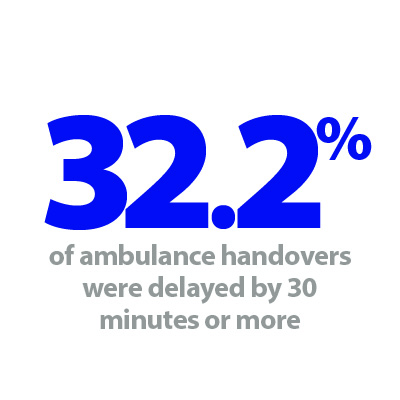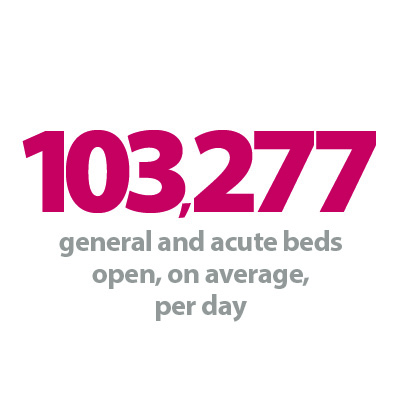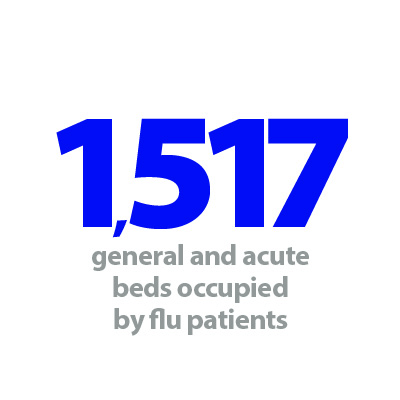


Introduction
Today NHS England published another release of its winter situation reports, offering valuable insight into the activity and demand across the NHS during the winter period.
This week's winter data, covering the period 15-21 January, continue to highlight the pressures trusts are facing as we see even more patients coming into hospitals with seasonal illnesses such as flu. Seasonal pressures, including the ongoing impact of Covid-19 and high bed occupancy levels across hospitals, demonstrates the sustained high demand for services once again this winter.
However, the hard work by staff should not go unnoticed, as this week's figures show a further increase in the number of open general and acute beds. Encouragingly, trusts have met the target of increasing core capacity by adding an extra 5,000 beds – a target set out in the NHS urgent and emergency recovery plan launched last year to tackle waiting times and improve patient experience.
Winter situation report (15 – 21 January)
A&E closures & diverts: There were no A&E closures this week. There were 28 A&E diverts this week, four more than the week prior and nine more than the same time last year.
Ambulance arrivals: A total of 90,115 patients arrived by ambulance. This is a slight decrease of 0.2% since last week but up by 15.6% compared to the same week last year.
Ambulance handovers: 32.2% of ambulance handovers were delayed by 30 minutes or more, up from 25.7% last week and up from 20.2% last year. 14% were delayed by 60 minutes or more. This is up from 9% last week and up from 6.6% last year. The total number of hours lost to handover delays has increased by 73% to 28,712 since last week. This is over 2.8 times higher than last year.
Critical care: Adult critical care bed occupancy is at 80.3% this week. This is an increase of 1.3 percentage points compared to last week (79%) and slightly below levels seen in the same week last year (80.6%).
Diarrhoea and vomiting (D&V): The number of beds closed due to D&V and norovirus has fallen this week, with an average of 549 closed per day. This is down from 586 last week but remains higher than this time last year (473).
Discharges: There were an average of 25,004 patients each day who no longer met the criteria to reside, an increase of 5.7%. Compared to last week, the same proportion of patients remained in hospital this week (57.7% or 14,436). This proportion is lower than the same time last year (59.3%).
Flu: This week the average number of general and acute beds occupied by flu patients each day increased by 13.6% to 1,517. An average of 65 critical care beds were occupied by flu patients each day this week (19.1% fewer than the week before).
General and acute (G&A) beds: There were an average of 103,277 G&A beds open each day across all acute trusts. On each day, 88 beds were unavailable and void to non-Covid admissions which is up from 75 last week. Average bed occupancy remains high at 94.3%.
Long stay: The number of patients staying in hospital longer than seven days increased slightly this week (up by 0.4%) but those staying longer than 14 and 21 days decreased by 1.2% and 1% respectively.
Neonatal intensive care beds: For all trusts, bed occupancy has increased this week to 68.3% from 67.6% last week. The average number of care beds open is at 1,706, six fewer beds open than last week and one more bed open compared to the same time last year.
Paediatric intensive care beds: For all trusts, bed occupancy has increased this week to 77.7%, up from 72.5% last week. The average number of care beds open this week has risen by one to 367.
Respiratory syncytial virus (RSV): An average of 17 paediatric beds were closed this week due to RSV symptoms, down from 30 last week and down from 31 the same time last year.
Staff absences: There were an average of 47,468 total absences each day this week, of which 4% were Covid-19 related (1,936). The total number of staff absences decreased from the week before and the proportion of Covid-19 related absences was smaller (down from 5%).
Our view
The data this week shows that trusts are still facing immense seasonal pressures as the number of patients in hospital with flu continues to rise. In the latest week, there were 1,517 patients in G&A beds with flu, the highest number seen so far this winter. The number of beds closed due to D&V also remains higher than levels seen last year.
Demand for urgent and emergency care is high, as 90,115 patients arrived by ambulance in the latest week. In recent weeks the time lost to ambulance handover delays was lower than last year. However, the data this week shows a stark jump in the time it has taken to hand a patient over from an ambulance to hospital.
Patient flow remains a cause for concern both for those being handed over to hospital but also for those waiting to be discharged. The average number of patients who are medically fit to be discharged but remain in hospital reached 14,436. This is the highest number recorded so far this winter.
With that said, the data also shows that G&A bed numbers have increased to 103,277 in the latest week, an increase of 1,804 beds. This increase demonstrates trusts' continued efforts and commitment to providing additional capacity to meet the needs placed on the health service over winter. There are now 5,000 additional core beds since 2022/23 which meets the target set out in the NHS urgent and emergency care recovery plan. However, G&A bed occupancy remains considerably high at 94% which emphasises the need for further investment in boosting capacity across all services, not just in hospitals.